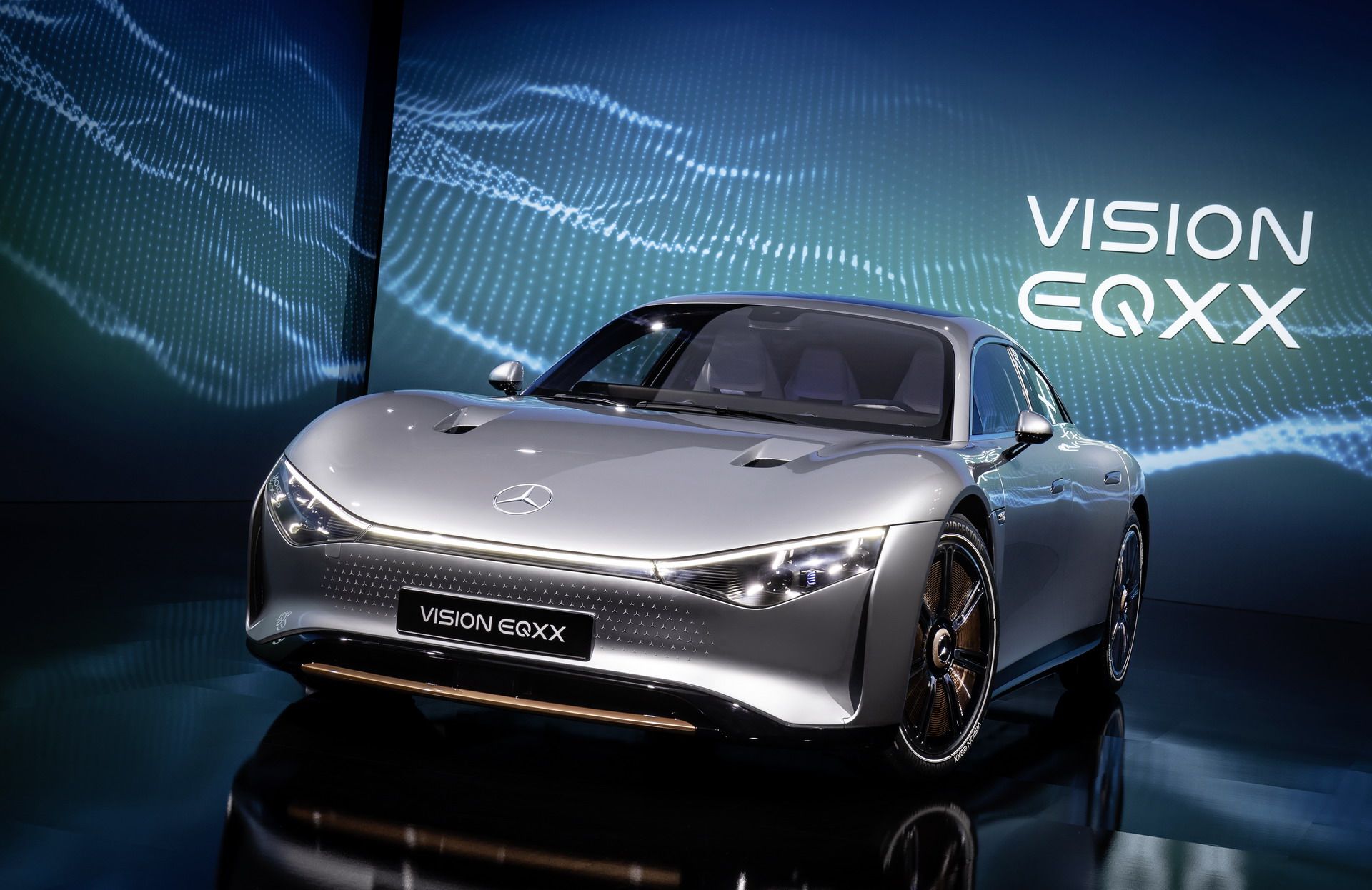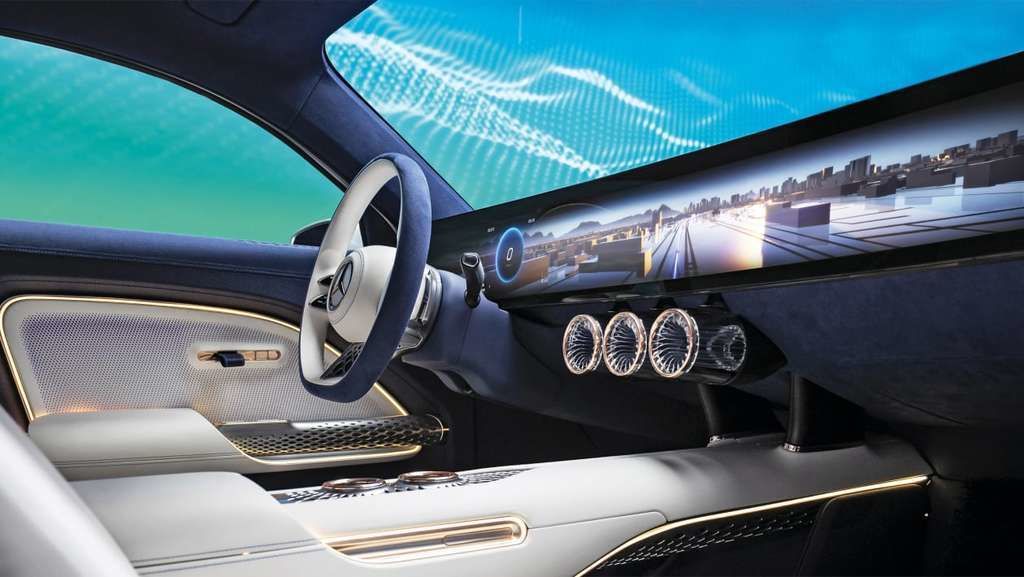
2022 novelty - Mercedes-Benz Vision EQXX
We would like to represent "the most efficient Mercedes ever created." This is not at all a kind of fairly fresh serial electric vehicles Mercedes EQS or EQE, but a completely original development. A sort of manifesto for the electromobility division of Mercedes-EQ, designed to demonstrate the direction in which the company's battery models are developing.
 The photo is taken from the site: https://news.myseldon.com/ru/news/index/264917296
The photo is taken from the site: https://news.myseldon.com/ru/news/index/264917296
The Vision EQXX project started just a year and a half ago. The main goal set for the developers was to make an electric car that can travel 1000 km on a single charge of the traction battery. Energy consumption should be less than 10 kWh per 100 km. And it should not be a small and light shell on bicycle wheels, but a “normal” car with a four-door body and a full interior. The concept is about five meters long, but the wheelbase (2800 mm) is shorter than that of the new production C-Class.
One of the main keys to solving the problem is aerodynamics. Mercedes-Benz Vision EQXX has a very low drag coefficient Cd: only 0.17 versus 0.20 for the production model Mercedes EQS. At the same time, it is important that the Vision EQXX cannot change the ride height, pressing against the road at high speed, and has only one movable aerodynamic element: this is a retractable diffuser under the rear bumper.
The silhouette with a long tail of the rear overhang works to improve aerodynamics, which “calms” the air flow descending from the roof. In addition, the body of the machine tapers towards the stern, mimicking the shape of a drop: the rear track width is 50 mm less than the front track width. The frontal projection area of the concept is smaller than that of the Mercedes CLA compact sedan. Of course, mirrors, underbody, wheels and other important elements are aerodynamically optimized.
The second way to increase energy efficiency is to reduce the weight of the machine. And here the Mercedes engineers also did a good job. The body is made primarily of ultra-high strength steel, but the doors are carbon fiber and fiberglass with aluminum reinforcements, and another 42 parts are made of UBQ composite material. It was developed by the Israeli company UBQ Materials, recycled materials were used to create it, while the resulting parts are 15-20% lighter than traditional ones.
And the main work of body art is a massive rear subframe with a separate name BIONEQXX. It is entirely cast from aluminum and has an openwork design with “holes” in unloaded areas. According to the same principle, the supports of the front suspension struts were designed and manufactured. By the way, fiberglass reinforced composite springs are used in the suspension itself: they were developed jointly with Rheinmetall Automotive and are lighter than traditional steel ones. And the brake discs are made of aluminum alloy. Against this background, 20-inch magnesium alloy wheels are no longer surprising.
 The photo is taken from the site: https://news.myseldon.com/ru/news/index/264917296
The photo is taken from the site: https://news.myseldon.com/ru/news/index/264917296
The concept is based on the promising MMA (Mercedes-Benz Modular Architecture) modular platform, and specialists from the Mercedes-Benz F1 High Performance Powertrain racing division were involved in the development of electrical engineering. The concept cannot surprise with the power supply and dynamics indicators: it has only one electric motor with a capacity of 204 hp. on the rear axle. But it is stated that the efficiency of the electric drive (“from the battery to the wheels”) reaches 95%. Although in Tesla production models this figure is 90-93%.
The traction battery with a capacity of “nearly 100 kWh” is twice as compact (primarily due to its thickness) and 30% lighter than that of a production Mercedes EQS electric vehicle. The developers do not reveal all the secrets, but a high energy consumption of 400 Wh/l was achieved, among other things, thanks to new anodes with a high silicon content.
Instead of a panoramic roof and rear window, a solar panel was installed, developed jointly with Solar Energy Systems ISE and the Fraunhofer Institute. It consists of 117 cells and under ideal conditions (that is, in sunny weather) is able to increase the range of an electric vehicle by 25 km per day. True, this is a calculated indicator, because the charge from the solar battery does not go to electric motors. It is stored in a separate lithium iron phosphate battery and used to power secondary systems such as climate control, headlights or media systems. But the charge of the main traction battery saved in this way will allow you to cover those same 25 km.
The concept has other promising features. For example, this is a screen in the entire width of the front panel. And if the serial Mercedes EQS has such a Hyperscreen actually consisting of three separate displays, then a single 47.5-inch screen with a resolution of 8K is really installed here. The media system itself with the beginnings of artificial intelligence was developed jointly with the Californian company BrainChip.
As a result, the Mercedes-Benz Vision EQXX weighs only 1750 kg. For such an electric vehicle, this is truly an outstanding result. For example, the serial BMW i4 liftback, even in the basic version with an 81 kWh battery and rear-wheel drive, pulls 2.1 tons, and the aforementioned Mercedes EQS weighs at least 2.4 tons. And the developers promise that the Vision EQXX will indeed be able to drive 1000 km on a single charge. But the real mileage has yet to be seen, because so far only virtual tests have been carried out.
 The photo is taken from the site: https://news.myseldon.com/ru/news/index/264917296
The photo is taken from the site: https://news.myseldon.com/ru/news/index/264917296
disscuss